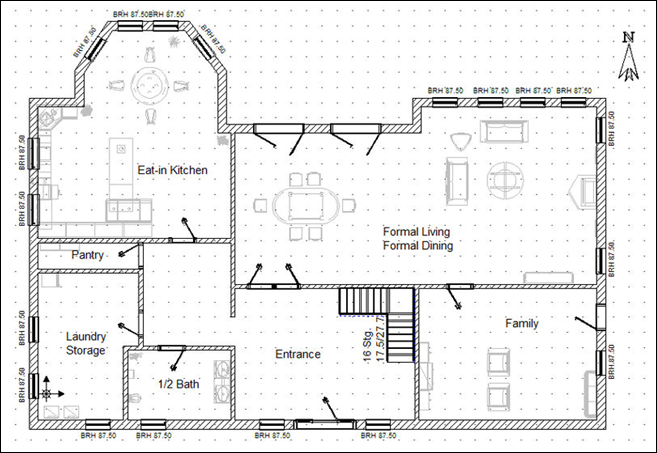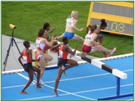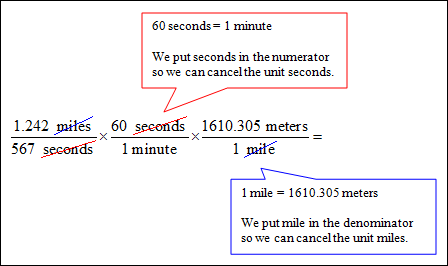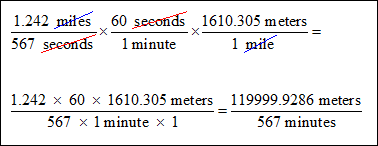INEQUALITIES AND MEASUREMENTS
 |
Unit Overview
In this unit, you will use the procedure to solve multi-step equations to solve multi-step inequalities and graph solutions on the number line. You will then examine how to convert measurements using dimensional analysis, a method used often in scientific studies. The study of measurement ends with a look at the exactness of a measurement and how to allow for variances.
Solving Multi-step Inequalities
Inequality - a mathematical statement that compares algebraic quantities.
*Solving inequalities is just like solving equations, use opposite operations to isolate the variable. |
Example #1: Solve the inequality for x: 3(5x – 7) ≥ 54
|
*When multiplying or dividing by a negative number, the inequality sign must be reversed.
Let’s take a look at why this rule applies.
Let’s say that we know 4 > 2. If we multiply both sides of this inequality by a –2, let’s see what happens to the inequality.
| 4 > 2 | *this is a true inequality |
| (–2)4 > (–2)2 | multiply both sides by –2 |
| –8 > –4 |
*the result is not a true statement; however, if we flip the inequality sign, the result will be a true statement. |
| –8 < –4 |
Example #2 Solve the inequality for y: 2y + 9 < 5y + 15
|
Example #3: Solve the inequality for x:
|
You can represent the solution of an inequality in one variable on a number line.
For < and > an open circle is used to denote that the solution number is not included in the solution.
For ≤ and ≥ a closed circle is used to denote that the solution number is included in the solution.
| Example #4: | x < 4 |
y ≥ –7 |
|
Stop! Go to Questions #1-9 about this section, then return to continue on to the next section.
Measurement
In the real world, measurements can seldom be exact. Sometimes, it is impossible to measure exactly because of the measurement tool. Other times, it is simply more expedient (easier) not to use an exact measurement. This gives us three types of measuring:
| Exact Measurement: The numbers used are literal and no margin of error is used when determining the answer. Estimation: The problem would be much easier to solve if we round some of the numbers and the information provided by rounding is still accurate enough to provide the answer needed. Approximation: When the measuring device is not accurate enough or the number in the problem is perhaps irrational (such as pi), then we approximate to the best of our ability. |
 Artworks makes flags for the football team. Consider each of the given scenarios about creating the flag and determine which type of accuracy is best described. Artworks makes flags for the football team. Consider each of the given scenarios about creating the flag and determine which type of accuracy is best described.Artworks needs to determine how much material to order. They know that 1500 flags will be printed so they take 18 × 15 (finding area) × 1500. |
![]() What type of measurement is used to determine the amount of material to order?
What type of measurement is used to determine the amount of material to order?
Estimation because they just needed an estimate to order the material.
"Click here" to check the answer.

![]() What type of measurement is used to determine the amount that will be collected?
What type of measurement is used to determine the amount that will be collected?
Exact, both numbers are used to state an exact amount determined.
"Click here" to check the answer.

![]() What type of measurement is used?
What type of measurement is used?
Approximation, this is as accurate as the measuring tape will show.
"Click here" to check the answer.
Note: In determining the type of measurement, another factor considered is that the measurement is accurate enough to make the design on the computer.
Stop! Go to Questions #10-12 about this section, then return to continue on to the next section.
Relative Error
Because no measurement is “exact,” we will examine how to find the relative error.
Relative error is the ratio of the absolute value of the difference of a measured value and and actual value, compared to the actual value.
 |
When relative error is expressed as a percent, it is called percent error.
*Note: The absolute value sign is used to provide a positive amount because we are not concerned if the value is over or under the actual value.
When dealing with measurements, the greatest possible error it is always
| Example: The floor plan below shows the measurements for a new home with the Family Room measuring a rectangular area of 12 ft by 14 ft. What is the greatest possible percent error in finding the area of the room? |
 |
Calculate the measured area.
|
| Calculate the minimum area with a greatest possible error of 1/2 ft. | Calculate the maximum area with a greatest possible error of 1/2 ft. | ||
| l = 12 − |
l = 12 + |
||
|
|
Find the differences:
| | minimum area | − | measured area | = | 155.25 − 168 | = | −12.75 | = 12.75 sq ft |
| | maximum area − measured area | = | 181.25 − 168 | = | −13.25 | = 13.25 sq ft |
Use the GREATER possible difference to compute the relative error. In this example, the greater difference in area is 13.25.
 |
By changing the ratio to a percent we can see the greatest possible percent error in area, based on measurements to the nearest foot, is about 8%.
Stop! Go to Questions #13-15 about this section, then return to continue on to the next section.
Measurement Conversions
Study the below example of using conversion factors to accurately compare or convert units.
 Example: Ozlem Kaya of Turkey ran the Steeplechase of 2000 meters in 10.05 minutes while Emma Coburn of the US ran the race of 1.242 miles in 567 seconds. Who had the better time? Example: Ozlem Kaya of Turkey ran the Steeplechase of 2000 meters in 10.05 minutes while Emma Coburn of the US ran the race of 1.242 miles in 567 seconds. Who had the better time? To compare the two times select one of the athletes and use conversions factors until you have the same units. |
| We will begin with Emma’s time. Emma's time is given in miles and seconds. We will convert her time to meters and minutes so that we can compare her time with Ozlem's time. We will use the process of dimemnsional analysis where we use equivalent measures of time and distance in fractional form. First, let's examine what we have and where we want to end. Emma's time: 1.242 miles in 567 seconds Ozlem's time: 2000 meters in 10.05 minutes So, we need to consider the conversion factors for: |
| miles |
seconds |
| 1 mile = 1610.305 meters | 60 seconds = 1 minute |
| Now, let's see how dimensional analysis can help us make this conversion. |
 |
| As we look over the cancellations, we see that we still have the units of meters and minutes. We need to compare Emma's time with Ozlem's time. Now, we must multiply the numbers in the numerator and denominator to make the conversion. |
 |
Now, we have numbers to compare that are in the same units.
|
| Let's convert both to unit rates (denominator equals 1) to determine the faster time. |
| Ozlem's unit rate: |
 |
| Emma's unit rate: |
 |
| Thus, Emma ran at a faster rate to complete the Steeplechase in the 2012 summer Olympics. |
Stop! Go to Questions #16-26 to complete this unit.

